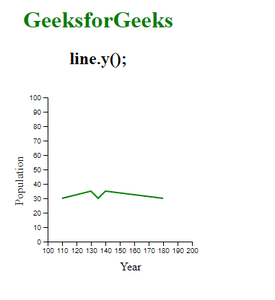line.y()函数用于将y访问器设置为函数或数字,然后将其返回给d3.line()函数调用的行生成器函数。如果未指定y,则它将返回当前的y访问器。
方法:在此示例中,要创建折线图,请首先创建SVG元素,并按照以下示例中的说明设置其宽度和高度。然后创建一个CSV文件,该文件的数据在示例中给出。我们将组容器附加到SVG。之后,使用d3.line()函数创建一个行生成器函数。
创建行生成器函数后,设置x-scale和y-scale域和范围,并将比例尺附加到SVG。然后使用line.x()和line.y()分别在x轴和y轴上提供x-scale数据和y-scale数据。之后,将路径附加到SVG,并将来自行生成器函数的数据提供给路径容器的“d”属性。给折线图一些样式,并完成它。
用法:
line.y([y]);
参数:该函数接受如上所述和以下描述的单个参数。
- y:该参数用于设置y-accessor。
返回值:此函数不返回任何内容。
下面给出的是上面给出的函数的一些例子。
例:
<!DOCTYPE html>
<html lang="en">
<head>
<meta charset="UTF-8" />
<meta
property="viewport"
content="width=device-width,
initial-scale=1.0"/>
<title>GeeksforGeeks</title>
<!--Fetching from CDN of D3.js -->
<script src=
"https://d3js.org/d3.v4.min.js">
</script>
</head>
<body>
<div style="width:300px; height:300px;">
<center>
<h1 style="color:green">
GeeksforGeeks
</h1>
<h2>
line.y();
</h2>
</center>
<svg width="300" height="300">
</svg>
</div>
<script>
// Selecting SVG and appending group tag
var svg = d3.select("svg")
.append("g")
.attr("transform",
"translate(80, -80)");
// Data for the CSV file
// year, population
// 110, 20
// 130, 25
// 135, 20
// 140, 25
// 180, 20
// Fetching data from CSV file
d3.csv("data.csv",
(data)=>{
// Setting domain and range of x-scale
var x = d3.scaleLinear()
.domain([100, 200])
.range([ 0, 200]);
// Appending x-axis
svg.append("g")
.attr("transform", "translate(0, 300)")
.call(d3.axisBottom(x));
svg.append("text")
.attr("transform", "translate(100, 340)")
.text("Year");
// Setting domain and range of y-scale
var y = d3.scaleLinear()
.domain([0, 100])
.range([ 200, 0 ]);
// Appending y-axis
svg.append("g")
.attr("transform", "translate(0, 100)")
.call(d3.axisLeft(y));
svg.append("text")
.attr("transform", "rotate(-90)")
.attr("y", -50)
.attr("x", -250)
.attr("dy", "1em")
.text("Population");
// Constructing line generator
var line=d3.line();
line.x(function(d) { return x(+d.year) });
// Using line.x() Function
line.y(function(d) { return y(+d.population) });
// Appending the path i.e the line
svg.append("path")
.datum(data)
.attr("stroke", "green")
.attr("stroke-width", "2")
.attr("fill", "none")
.attr("d", line)
.attr("transform", "translate(0, 80)");
});
</script>
</body>
</html>输出:
相关用法
- PHP imagecreatetruecolor()用法及代码示例
- p5.js year()用法及代码示例
- d3.js d3.utcTuesdays()用法及代码示例
- PHP ImagickDraw getTextAlignment()用法及代码示例
- PHP Ds\Sequence last()用法及代码示例
- PHP array_udiff_uassoc()用法及代码示例
- PHP geoip_continent_code_by_name()用法及代码示例
- d3.js d3.map.set()用法及代码示例
- PHP GmagickPixel setcolor()用法及代码示例
- PHP opendir()用法及代码示例
- PHP cal_to_jd()用法及代码示例
- d3.js d3.bisectLeft()用法及代码示例
- PHP stream_get_transports()用法及代码示例
- PHP Ds\Deque pop()用法及代码示例
注:本文由纯净天空筛选整理自tarun007大神的英文原创作品 D3.js line.y() Function。非经特殊声明,原始代码版权归原作者所有,本译文未经允许或授权,请勿转载或复制。

